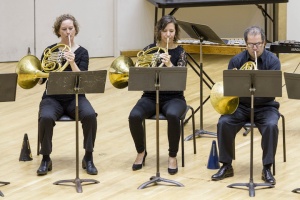The Well-Tempered Ear
Classical music education: How do you capture sound in pictures? Photographer Michael R. Anderson talks about his images of musicians at the UW-Madison School of Music. His photos are on show at the Lowell Center through April 30. A public reception is this Sunday afternoon 1-3.
1 Comment
By Jacob Stockinger
If you go to the official website (http://www.music.wisc.edu) and the A Tempo blog (https://uwmadisonschoolofmusic.wordpress.com) of the University of Wisconsin-Madison School of Music — and you really should do so regularly if you are a classical music fan in the Madison area — you are likely to see a lot of photographs taken by Michael R. Anderson.
So who is he?
And what does he say about his photographs, which feature striking compositions and a fine sense of animation?
You can judge for yourself from the new exhibition of his images at the Lowell Center, 610 Langdon Street, phone (608) 256-2621. It went up last Sunday, but has its official opening and reception this Sunday afternoon — with refreshments and with the photographer present — from 1 to 3 p.m.
The free exhibit runs through April 30 at the UW-Extension Building At some future time, according to UW School of Music officials, some of Anderson’s images will be put on display outside Mills Hall and Morphy Hall.
For more information, visit:
http://www.music.wisc.edu/events/photo-exhibit-mike-anderson/
Michael R. Anderson (below) kindly spoke to The Ear about his photo show:
Can you briefly introduce yourself to readers and tell them about your personal and professional interests?
I was born and raised in Wisconsin and graduated from the University of Wisconsin-Madison in 1970 with a degree in Chemistry. After teaching for nine years, I returned to school, earned a Ph.D. in Environmental Science and Engineering and subsequently worked for the Oregon Department of Environmental Quality. When we retired, my wife and I returned to Wisconsin.
How and when did your interest in photography start and what drew you to music as a subject matter?
In 1966 I went to summer school in Germany. An aunt lent me her Kodak Instamatic to take with me. I was surprised to find how much I enjoyed trying to capture that summer in pictures. I’ve enjoyed photography as a hobby ever since. Since my wife and I like to camp and hike, landscape and nature photography is a favorite subject.
Our older son, Eric, is a UW-Madison School of Music graduate. He’s now the band director at Verona Area High School and he also conducts the Verona Area Concert Band. My first real attempt to photograph musicians was when he asked me to take pictures of the Concert Band for their website. That turned out to be more fun than I had anticipated, and I’ve photographed them several times over the past few years.
How did you get started taking pictures for the UW-Madison School of Music?
Kathy Esposito, who manages Public Relations for the School of Music, placed an ad in a local photography newsletter seeking a volunteer to take pictures that she could use to update the school’s website. One of the joys of retirement is having time to volunteer for jobs like this, so I contacted her.
Do you have favorite areas of interest or subject matter —portraits, action shots, rehearsals or performances, individuals or groups?
Candid shots of the musicians rehearsing or performing are my favorite, especially those of individuals or small groups. Trying to capture their energy, emotion and concentration as they play is an interesting challenge.
Do you see any parallels between photography and music?
They’re both food for the right side of the brain. Life would be rather boring without the arts to inspire us.
Do you care to share any technical information (camera, lenses, flash, processing software, printer, paper) for those who are interested?
Photographers like to say that the equipment is not important. Nevertheless, many people, even other photographers, are interested. All but one of the photos in this exhibit were taken on a Canon 7D with a Canon 70-200 f/4L or a Canon EF-S 17-85 f/4-5.6 lens. Lightroom and Photoshop were used to process the RAW files and the pictures were printed on Red River Polar Matte paper with an Epson Stylus Photo R2000 printer.
What do you most enjoy about making photos of music? What aspect do you least enjoy or find most challenging?
Photography gives me a chance to describe an aural experience with a visual language. That’s an interesting task. The difficult part is that classrooms are not photo studios with plenty of bright lights. I often have to use slower shutter speeds and higher ISOs (film speeds) than I would like.
How many images to you generally shoot during a typical concert to arrive at a “keeper” shot?
This can vary quite a bit, depending on the type of scene I’m trying to capture as well as the lighting and other factors. But it’s not unusual to take 10-20 photos to get one I like. One is never enough, of course, so it’s easy to take several hundred during a concert to get a selection of final images that cover various phases of the performance.
What else would you like to say?
These photos capture just a few moments in time but the music lives on through the excellent programs and performances at the UW-Madison School of Music.
If your readers have additional questions, there will be an open house for this exhibit at the Lowell Center (below), 610 Langdon St., on this coming Sunday, March 8, from 1 to 3 p.m. At 2 p.m. I will make a few comments about the exhibit and answer questions.
Tags: Arts, band, brass, Canon, Chamber music, chemistry, choral music, Classical music, conductor, engineering, environment, Germany, harp, high school, Horn, Jacob Stockinger, Lightroom, Madison, Music, Orchestra, Oregon, photo, photography, Photoshop, Piano, science, University of Wisconsin System, University of Wisconsin-Madison School of Music, University of Wisconsin–Madison, Verona, vocal music, Wisconsin







